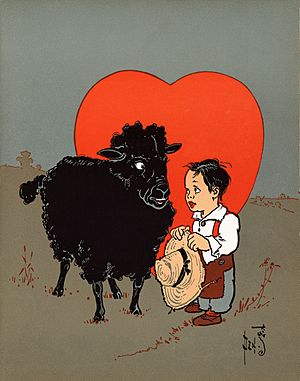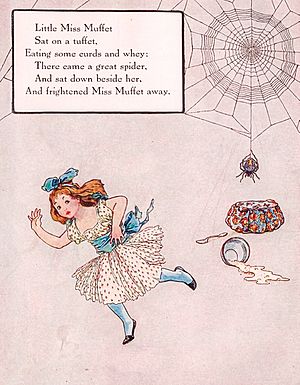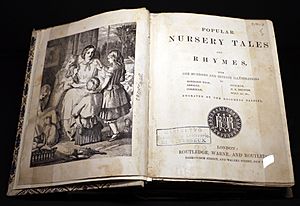Nursery rhyme facts for kids
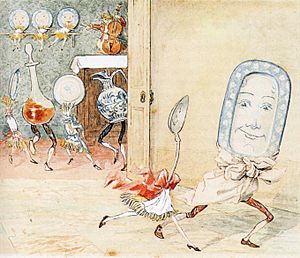
A nursery rhyme is a traditional song or poem taught to young children. Sometimes specific actions or dances are associated with particular songs. Learning such verses can assist in the development of vocabulary and counting skills. Eeny, meeny, miny, moe is an example of a counting-out game.
The term has been used since the 18th century or early 19th century. In North America, the term Mother Goose Rhymes, first used in the mid-18th century, is often used.
Examples of nursery rhymes are "Three Blind Mice", "Jack and Jill" and "Hey Diddle Diddle".
Many cultures feature children's songs and verses that are passed down by oral tradition from one generation to the next, however the term "nursery rhyme" generally refers to those of European origin. The best known examples are English and originated in or since the 17th century. Some however are substantially older, "Baa Baa Black Sheep" exists in written records as far back the Middle Ages. Arguably the most famous collection is that of Mother Goose. Some well known nursery rhymes originated in America, such as "Mary had a little lamb".
There are some aboriginal tribes which consider music sacred, so that only elder men may sing songs, and the songs are taught during sacred rituals in adulthood. It is forbidden for women or children to sing, so these cultures don't have these kinds of songs.
From the mid-16th century nursery rhymes begin to be recorded in English plays, and most popular rhymes date from the 17th and 18th centuries. The first English collections, Tommy Thumb's Song Book and a sequel, Tommy Thumb's Pretty Song Book, were published before 1744. Publisher John Newbery's stepson, Thomas Carnan, was the first to use the term Mother Goose for nursery rhymes when he published a compilation of English rhymes, Mother Goose's Melody, or, Sonnets for the Cradle (London, 1780).
History
Lullabies
The oldest children's songs of which we have records are lullabies, intended to help a child fall asleep. Lullabies can be found in every human culture. The English term lullaby is thought to come from "lu, lu" or "la la" sounds made by mothers or nurses to calm children, and "by by" or "bye bye", either another lulling sound or a term for good night. Until the modern era lullabies were usually only recorded incidentally in written sources. The Roman nurses' lullaby, "Lalla, Lalla, Lalla, aut dormi, aut lacta", is recorded in a scholium on Persius and may be the oldest to survive.
Many medieval English verses associated with the birth of Jesus take the form of a lullaby, including "Lullay, my liking, my dere son, my sweting" and may be versions of contemporary lullabies. However, most of those used today date from the 17th century. For example, a well known lullaby such as "Rock-a-bye, baby on a tree top", cannot be found in records until the late-18th century when it was printed by John Newbery (c. 1765).
Early nursery rhymes
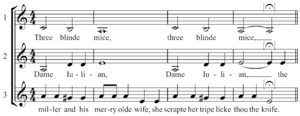
A French poem, similar to "Thirty days hath September", numbering the days of the month, was recorded in the 13th century. From the later Middle Ages there are records of short children's rhyming songs, often as marginalia. From the mid-16th century they begin to be recorded in English plays. "Pat-a-cake, pat-a-cake, baker's man" is one of the oldest surviving English nursery rhymes. The earliest recorded version of the rhyme appears in Thomas d'Urfey's play The Campaigners from 1698. Most nursery rhymes were not written down until the 18th century, when the publishing of children's books began to move from education towards entertainment, but there is evidence for many rhymes existing before this, including "To market, to market" and "Cock a doodle doo", which date from at least the late 16th century.
The first English collections, Tommy Thumb's Song Book and a sequel, Tommy Thumb's Pretty Song Book, are both thought to have been published by Mary Cooper in London before 1744, with such songs becoming known as 'Tommy Thumb's songs'. John Newbery's stepson, Thomas Carnan, was the first to use the term Mother Goose for nursery rhymes when he published a compilation of English rhymes, Mother Goose's Melody, or, Sonnets for the Cradle (London, 1780). These rhymes seem to have come from a variety of sources, including traditional riddles, proverbs, and ballads. About half of the currently recognised "traditional" English rhymes were known by the mid-18th century.
19th century
In the early 19th century printed collections of rhymes began to spread to other countries, including Robert Chambers's Popular Rhymes of Scotland (1826) and in the United States, Mother Goose's Melodies (1833). From this period we sometimes know the origins and authors of rhymes - for instance, in "Twinkle Twinkle Little Star" which combines the melody of an 18th-century French tune "Ah vous dirai-je, Maman" with a 19th-century English poem by Jane Taylor entitled "The Star" used as lyrics.
Early folk song collectors also often collected (what are now known as) nursery rhymes, including in Scotland Sir Walter Scott and in Germany Clemens Brentano and Achim von Arnim in Des Knaben Wunderhorn (1806–1808). The first, and possibly the most important academic collection to focus in this area was James Orchard Halliwell's The Nursery Rhymes of England (1842) and Popular Rhymes and Tales in 1849, in which he divided rhymes into antiquities (historical), fireside stories, game-rhymes, alphabet-rhymes, riddles, nature-rhymes, places and families, proverbs, superstitions, customs, and nursery songs (lullabies). By the time of Sabine Baring-Gould's A Book of Nursery Songs (1895), folklore was an academic study, full of comments and footnotes. A professional anthropologist, Andrew Lang (1844–1912) produced The Nursery Rhyme Book in 1897.
20th century
The early years of the 20th century are notable for the illustrations to children's books including Randolph Caldecott’s Hey Diddle Diddle Picture Book (1909) and Arthur Rackham's Mother Goose (1913). The definitive study of English rhymes remains the work of Iona and Peter Opie.


